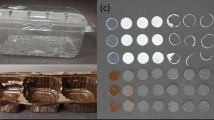Abstract
The polyester amide BAK 1095 is fully degraded by microorganisms. Bacteria that can grow on this polymer were isolated from various environments, such as freshwater, saltwater, arable land, woodland and compost. The mechanism of polymer degradation was examined using selected isolates. It was discovered that the bacteria selectively cleave the polymer at its ester bonds, releasing low-molecular water-soluble oligoamides. These can then be metabolised by other microorganisms [1, 2, 3]. The isolates were also tested for their ability to break down other ester-containing polymers such as Degranil W 50, a linear polyester urethane urea. Eight of the 12 strains examined were also able to break down this polymer.
The isolated microorganisms predominantly belong to the genus Bacillus. Mesophilic, halophilic and thermophilic species were isolated. The studies show that polyester amide-degrading bacteria occur in numerous ecosystems and provide data on the microbial breakdown of random copolymers. Information was also obtained on the mechanism involved in the microbial breakdown of polyester amides.
Similar content being viewed by others
REFERENCES
F. Kawai (1995) Adv. Biochem. Biotechnol. 52, 151–194.
T. Fukumura (1966) J. Biochem. 59, 531–536.
T. Fukumura (1966) J. Biochem. 59, 537–544.
R.-J. Müller (1996) Polycom (internet).
M. D. Faber (1979) Enzyme Microb. Technol. 1, 226–32.
Bayer AG (1997) Anwendungstechnische Information ATI 968 d, e.
Bayer AG (1997) Anwendungstechnische Information ATI 0110 d, e.
N. Pfenning, K. C. Lippert (1966) Arch. Microbiol. 55, 245–256.
E. A. Wolin, R. S. Wolfe, and M. J. J. Wolin (1964). J. Bacteriol. 87, 993–998.
R. E. Gordon, W. C. Haynes, and C. H.-N. Pang, (1973) The genus Bacillus, Agricultural Handbook No. 427, Agricultural Research Service, United States Department of Agriculture.
L. T. Miller (1982) Journ. Clin. Microbiol. 16, 584–586.
F. A. Rainey, N. Ward-Rainey, R. M. Kroppenstedt, and E. Stacke-brandt (1996) Int. Journ. of Syst. Bacteriol. 46, 1088–1092.
B. L. Maidak, G. J. Olsen, N. Larsen, M. J. Mc Caughey, and C. Woese (1996) Nucleic Acid Res. 24, 82–85.
N. Saitou and M. Nei (1987) Mol. Biol. Evol. 4, 406–425.
R. Timmerman, personal communication, unpublished results.
S. Kakudo, S. Negoro, I. Urabe, and H. Okada (1993) Appl. Environm. Microbiol. 59, 3978–3980.
S. Kakudo, S. Negoro, I. Urabe, and H. Okada (1995) J. Ferment. Bioeng. 80, 12–17.
H. P. Müller, R. Koch and H. Klein (1999) 6. Fachtagung, “Biologisch abbaubare Werkstoffe” February, 24–25th, 1999.
P. J. Dijkstra, H. Stapert, M. v. d. Zee, H. Feil, and J. Feijen (1997) IUPAC Symposium, Molecular Architecture for Degradable Polymers, Stockholm, June 10–13, 1997.
I. Molina, I. Villuendas, M. Bueno, J. J. Bou, J. A. Galbis, and S. Muñoz-Guerra (1997) IUPAC Symposium, Molecular Architecture for Degradable Polymers, Stockholm, Sweden, June 10–13, 1997.
K. Landgraf, and B. Rieger (1997) IUPAC Symposium, Molecular Architecture for Degradable Polymers, Stockholm, Sweden, June 10–13, 1997.
H. Hosoya, N. Miyazaki, Y. Sugisaki, E. Takanashi, M. Tsurufuji, M. Yamasaki, G. Tamura (1978) Agric. Biol. Chem. 42, 1545–1552.
H. G. Rast, personal communication; unpublished results.
J. Mergaert, and J. Swings (1996) J. Ind. Microb. Biotech. 17, 463–469.
A. L. Allen, J. Mayer, R. Stote, and D. L. Kaplan (1994) J. Environ. Polym. Degrad. 2, 237–244.
V. Andreoni, G. Baggi, C. Guaiti, and P. Mafrin (1995) Intern. Biodeteriorat. Biodegrad. 31, 41–53.
T. Fukumura (1996) Plant Cell Physiol. 7, 93–104.
T. Fukumura (1996) J. Biochem. 59, 537–544.
K. Kato, K. Ohtsuki, Y. Koda, T. Maekawa, T. Yomo, S. Negoro, and I. Urabe (1995) Microbiology 141, 2585–2590.
Ch. Sasikala and Ch. V. Ramana (1996) in S. L. Neidelman and A. I. Laskin (Ed.) Adv. Appl. Microbiol. 42, Academic Press, San Diego, pp. 97–218.
Y. Tokiwa, A. Iwamoto, and M. Koyama (1990) in J. E. Glass, and G. Swift, (Ed.) Agricultural and synthetic polymers, American Chemical Society, Washington, DC. pp. 136–148.
Y. Oda, N. Oida, T. Urakami, and K. Tonomura (1997) FEMS Microbiology letters 152, 339–343.
C. A. Murphy, J. A. Cemeron, S. J. Huang, and R. T. Vinopal (1996) Appl. Environ. Microbiol. 62, 456–460.
Y. Oda, H. Asari, T. Urakami, K. Tonomura (1995) J. Ferment. Bioeng. 80, 265–269.
M. Tsuji and I. Yoshihiro (1978) Hakko Kogaku Kaishi, 56, 799–801.
F. Lefebvre, C. David, and C. Vanderwauven (1996) Polym. Degrad. Stabil. 45, 347–353.
F. Lefebvre, A. Daro, and C. David (1995) J. Macromol. Sci., Pure Appl. Chem. A32, 867–873.
H. Pranamuda, Y. Tokiwa, and H. Tanaka (1995) Appl. Environ. Microbiol. 61, 1828–1832.
C. Ruiz, and G. T. Howard (1997) 97th General Meeting, ASM, Miami Beach, Florida, May 4–8, 1997.
T. Nakajima-Kambe, F. Onuma, N. Kimpara, and T. Nakahara (1995) FEMS Microbiology Letters 129, 39–42.
T. Nakajima-Kambe, F. Onuma, Y. Akutsu, and T. Nakahara (1997) J. Ferment. Bioeng. 83, 456–460.
R. Pryor, U. Charyulu, S. Haddad, R. K. Prakash, and G. L. Bowers-Irons (1991) Report, Order No. AD-A232 948, 10 pp.; From: Gov. Rep. Announce. Index (U.S.) 91, Abstr. No. 52, 918.
G. L. Bowers-Irons, R. Pryor, U. Charyulu, and R. K. Prakash (1991) Report, Order No. AD-A232 108, 9 pp.; From: Gov. Rep. Announce. Index (U.S.) 91, Abstr. No. 140, 927.
R. W. Lenz (1993) Adv. Polym. Sci. 107, 1–40.
Y. Tokiwa, H. Tanaka, P. Harudanin, and M. Yahata (1995), Patent JP 95–160501 19950627.
H. Pranamuda, Y. Tokiwa, and H. Tanaka (1997) Appl. Environ. Microbiol. 63, 1637–1640.
A. Schirmer, C. Matz, and D. Jendrossek (1995) Can. J. Microbiol. 41, 170–179.
J. R. Müller, U. Witt, and W.-D. Deckwer (1997) Fett/Lipid 99, 40–45.
Author information
Authors and Affiliations
Rights and permissions
About this article
Cite this article
Wiegand, S., Steffen, M., Steger, R. et al. Isolation and Identification of Microorganisms Able to Grow on the Polyester Amide BAK 1095. Journal of Polymers and the Environment 7, 145–156 (1999). https://doi.org/10.1023/A:1022897622312
Issue Date:
DOI: https://doi.org/10.1023/A:1022897622312




